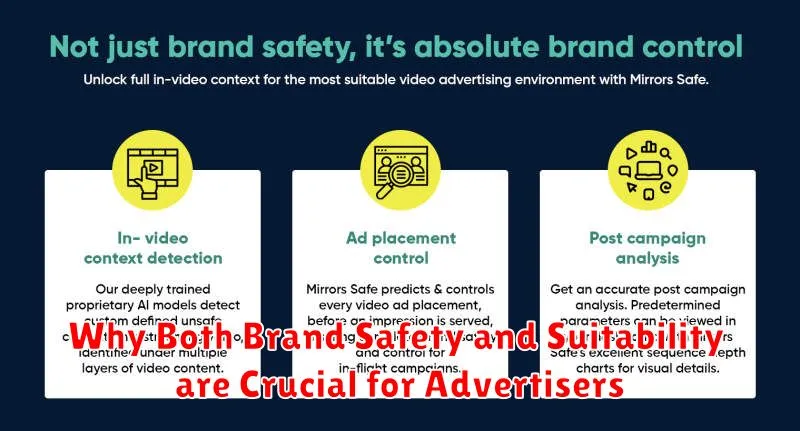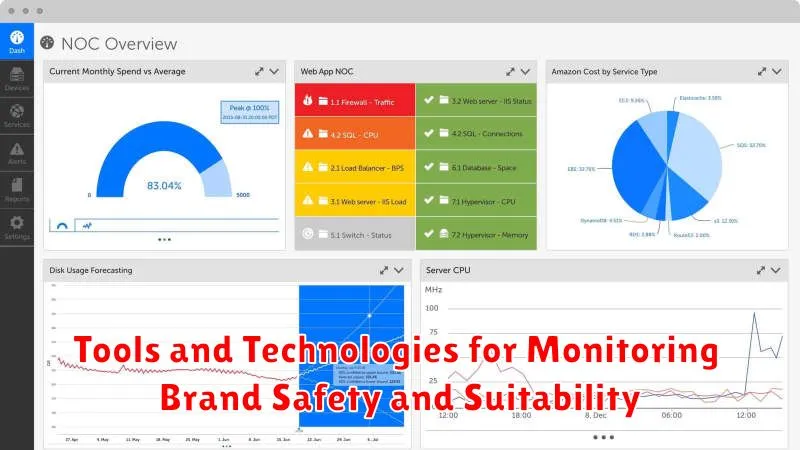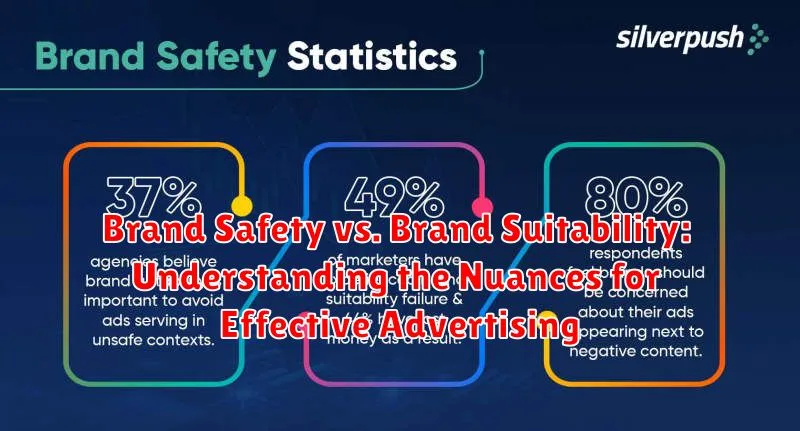In today’s complex digital landscape, advertising success hinges not only on reaching the right audience but also on ensuring the right context. As brands navigate the ever-expanding world of online platforms and content, understanding the critical distinction between brand safety and brand suitability becomes paramount. This article delves into the nuances of these two concepts, providing a comprehensive overview of their differences and how both are essential for maintaining a positive brand image and achieving effective advertising campaigns across various global markets.
While both brand safety and brand suitability aim to protect a brand’s reputation, they address different levels of risk. Brand safety is about avoiding association with overtly harmful content, such as hate speech, violence, or illegal activities. On the other hand, brand suitability focuses on aligning a brand’s message with content that resonates with its values and target audience, even if that content is not inherently harmful. Neglecting either of these aspects can lead to damaged reputation, consumer backlash, and ultimately, a decrease in advertising ROI. This article explores practical strategies to implement robust brand safety measures and develop a sophisticated understanding of brand suitability for impactful advertising results.
Defining Brand Safety: Protecting Your Brand’s Reputation
Brand safety refers to the measures taken to protect a brand’s reputation and image by avoiding association with inappropriate or harmful content.
This encompasses safeguarding against ads appearing alongside content that is illegal, offensive, or damaging. Such content could include:
- Hate speech
- Terrorist propaganda
- Pornography
- Fake news
- Violent content
The goal of brand safety is to ensure that advertising placements do not negatively impact consumer perception of the brand. It focuses on preventing direct damage to brand equity through association with demonstrably harmful environments.
A strong brand safety strategy is essential for maintaining trust and credibility with consumers.
Defining Brand Suitability: Aligning Your Brand with the Right Content
While brand safety focuses on avoiding negative or harmful contexts, brand suitability delves into whether the content aligns with your brand’s values, target audience, and overall marketing objectives. It’s about finding the right fit, not just avoiding the wrong one.
Brand suitability considers factors beyond immediate risk, such as:
- Audience Demographics: Is the content appropriate for the age, interests, and values of your target audience?
- Content Tone and Style: Does the content’s tone, style, and messaging complement your brand’s voice and personality?
- Brand Values: Does the content reflect and reinforce your brand’s core values and beliefs?
- Campaign Goals: Does the content support your specific campaign objectives, such as driving awareness, generating leads, or increasing sales?
For example, a lighthearted, humorous advertisement may be brand safe on a news website, but it might not be brand suitable if the news story is about a serious or tragic event.
The Key Differences Between Brand Safety and Brand Suitability
While both brand safety and brand suitability are critical for protecting and enhancing a brand’s image, they address distinct concerns. The primary difference lies in their focus: brand safety aims to *avoid* association with inappropriate or harmful content, whereas brand suitability seeks to *align* with content that resonates positively with the brand’s values and target audience.
Consider the following table which highlights the key differences:
| Feature | Brand Safety | Brand Suitability |
|---|---|---|
| Objective | Avoidance of harm | Positive alignment |
| Focus | Inappropriate/harmful content | Relevant/engaging content |
| Risk | Reputational damage due to association with negative content | Missed opportunities to connect with the right audience or diluted brand messaging |
In essence, brand safety is about damage control and risk mitigation, while brand suitability is about optimizing brand perception and marketing effectiveness. Think of brand safety as a baseline requirement and brand suitability as a strategic enhancement.
Why Both Brand Safety and Suitability are Crucial for Advertisers

For advertisers, prioritizing both brand safety and brand suitability is paramount for achieving marketing objectives and maintaining a positive brand image. Brand safety ensures that advertisements are not displayed alongside inappropriate or harmful content, thus preventing negative associations that could damage brand reputation. A failure to uphold brand safety measures may result in significant financial losses as well as reputational harm.
Brand suitability goes beyond mere avoidance of harmful content; it focuses on aligning advertisements with content that resonates with the brand’s values and target audience. This alignment enhances the relevance and impact of the advertisement, potentially leading to increased engagement and conversion rates. When advertisements are placed in suitable environments, consumers are more likely to view the brand positively and perceive it as authentic and trustworthy.
Essentially, brand safety is a baseline requirement for avoiding damage, while brand suitability is a strategic approach to maximizing positive impact. By implementing robust strategies for both, advertisers can safeguard their brand equity and enhance their marketing effectiveness.
The Risks of Ignoring Brand Safety and Suitability
Ignoring brand safety and suitability can lead to significant repercussions for advertisers. A breach of brand safety exposes your brand to association with inappropriate or harmful content, resulting in reputational damage and a loss of consumer trust.
Conversely, neglecting brand suitability, even if the content is technically “safe,” can lead to ineffective advertising. Placing ads in contexts that don’t resonate with your target audience or align with your brand values can result in wasted ad spend and a failure to achieve marketing objectives.
Financial losses are a direct consequence of both. Negative brand perception can drive away customers, impacting sales and overall revenue. Furthermore, associating with unsuitable content can damage long-term brand equity, making it more difficult to build and maintain a positive brand image.
Strategies for Ensuring Brand Safety in Digital Advertising
Ensuring brand safety in the digital landscape requires a multi-faceted approach. Implementing these strategies minimizes the risk of your brand appearing alongside inappropriate content.
Utilize Exclusion Lists
Maintain comprehensive lists of websites, keywords, and topics that are considered unsafe or detrimental to your brand image. Regularly update these lists based on emerging trends and potential threats.
Employ Contextual Targeting
Leverage contextual targeting to ensure your ads appear only on pages with relevant and brand-appropriate content. This goes beyond simple keyword matching and considers the overall context of the webpage.
Partner with Reputable Publishers and Platforms
Prioritize advertising on established platforms and within trusted publisher networks that have a proven track record of maintaining brand safety standards. Perform due diligence before partnering with new entities.
Implement Third-Party Verification Tools
Utilize third-party verification tools to monitor ad placements and identify potential brand safety violations. These tools provide valuable insights and help automate the process of identifying and blocking unsafe content.
Regularly Monitor and Analyze Performance
Continuously monitor your campaigns and analyze performance data to identify any brand safety issues. Use this data to refine your strategies and optimize your targeting.
How to Determine Brand Suitability Guidelines for Your Brand
Establishing clear brand suitability guidelines is essential for ensuring your advertisements appear in contexts that resonate positively with your target audience and reflect your brand values. This process requires a deep understanding of your brand’s identity and the nuances of the digital landscape.
First, conduct a thorough brand audit. Define your brand’s core values, mission, and target audience. Identify potentially harmful content categories that conflict with your brand image.
Next, analyze your audience’s preferences and sensitivities. Understand what type of content aligns with their interests and values. Consider factors like age, cultural background, and social attitudes.
Develop a comprehensive list of content categories to avoid. This could include topics such as hate speech, violence, political extremes or overly sexual content.
Finally, regularly review and update your guidelines. The digital landscape is constantly evolving, so your brand suitability standards should adapt accordingly.
Tools and Technologies for Monitoring Brand Safety and Suitability

Effectively managing brand safety and suitability requires leveraging a variety of tools and technologies. These resources help advertisers identify and mitigate risks associated with inappropriate or misaligned content.
Keyword Blocking and Filtering: These tools allow advertisers to create blacklists of keywords and phrases that are deemed unsafe or unsuitable for their brand. They work by preventing ads from appearing on pages or within content containing these terms.
Contextual Analysis: Advanced contextual analysis technology goes beyond simple keyword matching. It analyzes the meaning and sentiment of the content surrounding an ad placement to determine if it aligns with the brand’s values and messaging.
Brand Safety Platforms: These platforms offer comprehensive solutions for monitoring brand safety and suitability. They often include features such as real-time monitoring, reporting, and blocking capabilities across various channels.
Third-Party Verification: Independent verification services provide unbiased assessments of ad placements, ensuring they meet established brand safety and suitability standards. These services often offer certification and reporting to validate compliance.
AI and Machine Learning: Artificial intelligence (AI) and machine learning (ML) are increasingly being used to detect and prevent brand safety violations. These technologies can identify patterns and anomalies that traditional methods may miss, improving the accuracy and efficiency of brand protection efforts.
Best Practices for Managing Brand Safety and Suitability in Programmatic Advertising
Programmatic advertising demands a proactive approach to both brand safety and brand suitability. Effectively managing these aspects requires careful planning and execution.
Utilizing Advanced Targeting Options
Leverage the granular targeting options within programmatic platforms to reach specific audiences and demographics. Ensure that your target audience aligns with the values and image you want to project for your brand.
Employing Exclusion Lists and Blacklists
Maintain regularly updated exclusion lists and blacklists to prevent your ads from appearing on websites or alongside content that is deemed unsafe or unsuitable. This proactive measure is crucial for safeguarding your brand’s reputation.
Implementing Contextual Targeting
Utilize contextual targeting to place your ads alongside relevant content. This can improve brand suitability by ensuring that your ads appear in environments that are appropriate for your brand’s message and target audience.
Regular Monitoring and Reporting
Continuously monitor your programmatic campaigns to identify potential brand safety or suitability issues. Generate regular reports to track performance and make data-driven adjustments to your strategy.
Collaborating with Trusted Partners
Work with reputable programmatic advertising platforms and partners who prioritize brand safety and suitability. Choose partners with transparent policies and robust monitoring capabilities.

